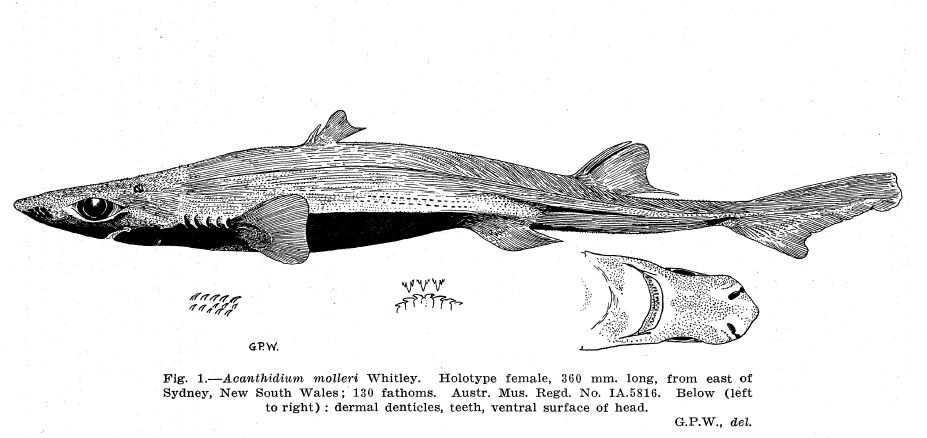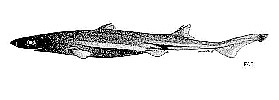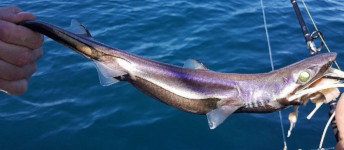Etmopterus molleri
(Whitley, 1939)
Slendertail lanternshark
Classification: Elasmobranchii Squaliformes Etmopteridae
Reference of the original description
Studies in Ichthyology. No. 12. Records of the Australian Museum, 20(4), 264–277
Studies in Ichthyology. No. 12. Records of the Australian Museum, 20(4), 264–277
Image of the original description

Etmopterus molleri (Whitley, 1939) as Acanthidium molleri Whitley. Holotype female, 360 mm. long, from east of Sydney, New South Wales; 130 fathoms. Austr. Mus. Regd. No. IA.5816. Below (left to right): dermal denticles, teeth, ventral surface of head.

Etmopterus molleri (Whitley, 1939) as Acanthidium molleri Whitley. Holotype female, 360 mm. long, from east of Sydney, New South Wales; 130 fathoms. Austr. Mus. Regd. No. IA.5816. Below (left to right): dermal denticles, teeth, ventral surface of head.
Synonyms / new combinations and misspellings
Acanthidium molleri, Acanthidium (Acanthidium) molleri, Etmopterus cf. molleri
Acanthidium molleri, Acanthidium (Acanthidium) molleri, Etmopterus cf. molleri
Description :
Citation: Etmopterus molleri (Whitley, 1939): In: Database of modern sharks, rays and chimaeras, www.shark-references.com, World Wide Web electronic publication, Version 12/2025
Please send your images of "Etmopterus molleri" to info@shark-references.com

Etmopterus molleri (Whitley, 1939) © Dr. Nicolas Straube, Curator of Ichthyology & Associate Professor, Department of Natural History, University Museum of Bergen

Etmopterus molleri (Whitley, 1939) © Dr. Nicolas Straube, Curator of Ichthyology & Associate Professor, Department of Natural History, University Museum of Bergen
Common names
 Blackbelly lanternshark,
Blackbelly lanternshark,  Moller"s lantern shark,
Moller"s lantern shark,  Moller"s lanternshark,
Moller"s lanternshark,  Mollers deepsea shark,
Mollers deepsea shark,  Mollers lantern shark,
Mollers lantern shark,  Slendertail lantern shark,
Slendertail lantern shark,  Slendertail lanternshark
Slendertail lanternshark
 Blackbelly lanternshark,
Blackbelly lanternshark,  Moller"s lantern shark,
Moller"s lantern shark,  Moller"s lanternshark,
Moller"s lanternshark,  Mollers deepsea shark,
Mollers deepsea shark,  Mollers lantern shark,
Mollers lantern shark,  Slendertail lantern shark,
Slendertail lantern shark,  Slendertail lanternshark
Slendertail lanternshark
Short Description
A moderately small Etmopterus belonging to the E. lucifer group by having elongated anterior and posterior branches of lateral flank marking, and differing from other members by the following combination of characters: hook-like dermal denticles not overlapping each other, in well-defined rows; the origin of second dorsal fin well posterior to flank-marking base origin; infracaudal marking not connected with caudal-fin base marking through luminous lines; a long posterior caudal-fin marking, length 18.8–38.1% caudal-fin length; caudal fin black; caudal-base marking bifurcated before caudal-fin origin; and ventral pectoral marking curved [34277].
Original Diagnosis after Whitley, 1939 [11540]: A deep-sea shark with five gill-slits, no anal fin, each dorsal fin preceded by a prominent spine, and with glandular areas (probably luminous organs) on the lower parts of the body. General facies of the genotype of Acanthidium as figured in Lowe's Fishes of Madeira, Sept., 1843, p. 37, pI. vi, but distinguished by its much longer snout, more oblique nostrils, and various minor characters, as described below. Head acute, somewhat flattened, about :t of the total length and nearly twice the depth of the body. Width of head across gills subequal to preoral length. A cilain of pores on each side of fontanelle. Eye very large. Spiracles large. Nostrils large, oblique. Some crescentic creases across chin. Mouth transverse, not notably arched, and with long oblique lateral folds. Teeth of upper jaw in several series, pentacuspid, each tooth with a long central cusp and two small acute cusps on each side of it. Lower jaw teeth in a Single row, unicuspid, their sides touching and their points deflected laterally. Five small curved gill-openings, the last at the pectoral origin. Body elongate, finely tapering posteriorly. The back is rounded but the ventral surface is somewhat flattened. Lateral line present. The ventral surface of head and body is covered with a blackish area, probably luminescent, which sends longitudinal branches of glandular skin along the sides between the ventral fins and the second dorsal and also on the lower parts of the caudal root. A series of black spots along the median line of the back and two or three more on the sides below the lateral line are discernible against the general dark brown ground-colour of the shark. The skin is densely invested with hook-like dermal denticles arranged in many longitudinal rows. Dorsal fins preceded by prominent spines with shallow lateral grooves. Spine of first dorsal equidistant from nostril and second dorsal. Length of base of first dorsal fin (without the spine) about one-tenth dorsal interspace. Second dorsal fin much larger than first; both the fins thin and fragile. No anal fin. Pectorals small, their lower rays produced into a slight, blunt lobe. Ventral fins low, united around vent; their origins are nearer the pectorals than the caudal. Caudal fin shorter than head, with a notch below its terminal part.
Described and figured from the holotype of the new species, the larger of two females (360 mm. or 1H inches) from the same locality. Austr. Mus. Regd. Nos. IA.5816 (holotype) and 5817 (paratype).
Loc.-About thirty miles eastward of Sydney, New South Wales; trawled in 130 fathoms depth in June, 1933, by Captain K. Moller, in whose honour the species is named. The trawlers very rarely fish in this great depth, and on that occasion three other species of fishes were secured: Undecimus hendecacanthus (McCulloch), Centriscops obZiquus Waite, and Owstonia maccullochi Whitley; these were new records for this State and were recorded in the supplement to the third edition of McCulloch's Fishes of New South Wales in 1934. The sharks, however, were set. aside until now for determination.
A moderately small Etmopterus belonging to the E. lucifer group by having elongated anterior and posterior branches of lateral flank marking, and differing from other members by the following combination of characters: hook-like dermal denticles not overlapping each other, in well-defined rows; the origin of second dorsal fin well posterior to flank-marking base origin; infracaudal marking not connected with caudal-fin base marking through luminous lines; a long posterior caudal-fin marking, length 18.8–38.1% caudal-fin length; caudal fin black; caudal-base marking bifurcated before caudal-fin origin; and ventral pectoral marking curved [34277].
Original Diagnosis after Whitley, 1939 [11540]: A deep-sea shark with five gill-slits, no anal fin, each dorsal fin preceded by a prominent spine, and with glandular areas (probably luminous organs) on the lower parts of the body. General facies of the genotype of Acanthidium as figured in Lowe's Fishes of Madeira, Sept., 1843, p. 37, pI. vi, but distinguished by its much longer snout, more oblique nostrils, and various minor characters, as described below. Head acute, somewhat flattened, about :t of the total length and nearly twice the depth of the body. Width of head across gills subequal to preoral length. A cilain of pores on each side of fontanelle. Eye very large. Spiracles large. Nostrils large, oblique. Some crescentic creases across chin. Mouth transverse, not notably arched, and with long oblique lateral folds. Teeth of upper jaw in several series, pentacuspid, each tooth with a long central cusp and two small acute cusps on each side of it. Lower jaw teeth in a Single row, unicuspid, their sides touching and their points deflected laterally. Five small curved gill-openings, the last at the pectoral origin. Body elongate, finely tapering posteriorly. The back is rounded but the ventral surface is somewhat flattened. Lateral line present. The ventral surface of head and body is covered with a blackish area, probably luminescent, which sends longitudinal branches of glandular skin along the sides between the ventral fins and the second dorsal and also on the lower parts of the caudal root. A series of black spots along the median line of the back and two or three more on the sides below the lateral line are discernible against the general dark brown ground-colour of the shark. The skin is densely invested with hook-like dermal denticles arranged in many longitudinal rows. Dorsal fins preceded by prominent spines with shallow lateral grooves. Spine of first dorsal equidistant from nostril and second dorsal. Length of base of first dorsal fin (without the spine) about one-tenth dorsal interspace. Second dorsal fin much larger than first; both the fins thin and fragile. No anal fin. Pectorals small, their lower rays produced into a slight, blunt lobe. Ventral fins low, united around vent; their origins are nearer the pectorals than the caudal. Caudal fin shorter than head, with a notch below its terminal part.
Described and figured from the holotype of the new species, the larger of two females (360 mm. or 1H inches) from the same locality. Austr. Mus. Regd. Nos. IA.5816 (holotype) and 5817 (paratype).
Loc.-About thirty miles eastward of Sydney, New South Wales; trawled in 130 fathoms depth in June, 1933, by Captain K. Moller, in whose honour the species is named. The trawlers very rarely fish in this great depth, and on that occasion three other species of fishes were secured: Undecimus hendecacanthus (McCulloch), Centriscops obZiquus Waite, and Owstonia maccullochi Whitley; these were new records for this State and were recorded in the supplement to the third edition of McCulloch's Fishes of New South Wales in 1934. The sharks, however, were set. aside until now for determination.
Distribution
Southwestern Pacific, off southeastern Australia to northern New Zealand, and New Caledonia [34277].
Note on the gbif records: The map does not take into account the taxonomic changes from Ng et al. (2025)! [34277] Source: www.gbif.org
Southwestern Pacific, off southeastern Australia to northern New Zealand, and New Caledonia [34277].
Note on the gbif records: The map does not take into account the taxonomic changes from Ng et al. (2025)! [34277] Source: www.gbif.org
Human uses
fisheries: of no interest
fisheries: of no interest
Biology
Ovoviviparous [578]. Size at birth about 15 cm [1388]. Distinct pairing with embrace [17086]. Found on the continental shelf and slope (Ref. 75154).
Ovoviviparous [578]. Size at birth about 15 cm [1388]. Distinct pairing with embrace [17086]. Found on the continental shelf and slope (Ref. 75154).
Size / Weight / Age
Up to 433 mm TL and 366 mm TL for females and males, respectively. Smallest mature female and male examined are 333 and 335 mm TL, respectively [34277].
Up to 433 mm TL and 366 mm TL for females and males, respectively. Smallest mature female and male examined are 333 and 335 mm TL, respectively [34277].
Dentition
Teeth dissimilar in upper and lower jaw, having ontogenetic change and sexual dimorphism; multicuspid upper teeth in three functional series; unicuspid lower teeth in three series, with one functional; lower teeth blade-like, strongly oblique. No symphyseal and intermediate teeth. Upper teeth cusp thick; immature males and females with 1–2 cusplets on each side of the upper teeth (rarely 3 in mature females), while mature males having 3–4 cusplets (Fig. 3C); longest cusplet length about two-third of the cusp in mature individuals; cusp and cusplets of upper teeth narrowly triangular, lower teeth of mature individuals not erected. Tooth count of upper jaw 23–26, lower jaw 38–40, total count 61–66. [34277];
Teeth dissimilar in upper and lower jaw, having ontogenetic change and sexual dimorphism; multicuspid upper teeth in three functional series; unicuspid lower teeth in three series, with one functional; lower teeth blade-like, strongly oblique. No symphyseal and intermediate teeth. Upper teeth cusp thick; immature males and females with 1–2 cusplets on each side of the upper teeth (rarely 3 in mature females), while mature males having 3–4 cusplets (Fig. 3C); longest cusplet length about two-third of the cusp in mature individuals; cusp and cusplets of upper teeth narrowly triangular, lower teeth of mature individuals not erected. Tooth count of upper jaw 23–26, lower jaw 38–40, total count 61–66. [34277];
Remarks
shark-references Species-ID=2178;
shark-references Species-ID=2178;




















